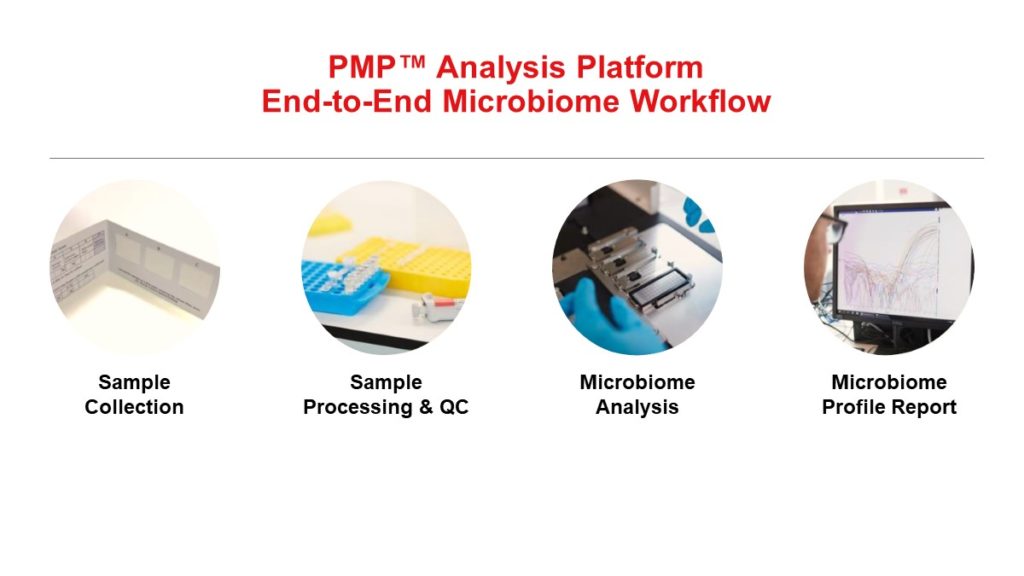Bringing Higher Resolution and Faster Analysis to Human Microbiome Profiling
Microbiome Q & A with Dr. Anne-Grethe Reichelt of Bio-Me
For researchers, clinicians, and consumers, the role of the microbiome in wellbeing and disease research is top-of-mind. An incredible number of exploratory studies have now been published about the composition of the human microbiome and its association with various aspects of human physiology. Many pre- and probiotic products have also made their way to market, touting claims about their beneficial impact on the human microbiome.
The era of the microbiome was brought on by the widespread permeation of next-generation sequencing (NGS) into the research world, enabling scientists to analyze complex collections of microbes collected from different biospecimens.
However, few actionable insights have been gleaned from the vast amount of NGS-fueled exploration studies that have been published. In addition, NGS still poses several challenges for researchers, including multi-week workflows and complex bioinformatics analysis.

For Dr. Anne-Grethe Reichelt, International Sales and BD Manager at Bio-Me, these drawbacks are significant barriers to progress in the clinical research and consumer world. “Sequencing is great, particularly for exploratory studies, states Reichelt, “But it takes time, is costly, and doesn’t fit into the clinical research world.” To overcome these challenges, Bio-Me has teamed up with Thermo Fisher Scientific to create a qPCR-based platform – called Precision Microbiome Profiling (PMP™) – that provides rapid, accurate, and high-resolution insights into microbiome composition.
To learn more about the power of PMP, we sat down with Reichelt for a Q & A about the current gaps in microbiome analysis, how Bio-Me and Thermo Fisher Scientific are filling those gaps, and the future of microbiome research.
Can you summarize what PMP is?
PMP is a qPCR-based microbiome analysis platform. We’ve collaborated with Thermo Fisher Scientific to design and develop PMP, and it’s built using Thermo Fisher Scientific’s OpenArray® technology. This technology enables incredibly high-throughput testing. We did a series of tests and assay development where we took everything sequenced and relevant to human health or disease research. Then, we summarized it down into specific microbial targets and got that resolution that you usually can’t get with NGS methods.

Figure 1. Steps for a high throughput qPCR-based microbiome analysis. include sample collection, sample processing’s & QC, microbiome analysis using QuantStudio12K Open Array, and generating a microbiome profile report. Above is a visual example of the PMP Analysis Platform.
Can you describe the current tools and techniques for microbiome analysis and how Bio-Me’s approach is different?
Next-generation sequencing (NGS) has been the analysis option of choice for the human microbiome. And sequencing is great, particularly for exploratory studies. Sequencing can provide much information if you don’t know what microbes you’re looking for (or even if you do).
But it takes time, is costly, and doesn’t fit into the clinical world. When you use PMP, you can go down to a much higher resolution at the level of species and strains.
How do you see microbiome analysis applied in the clinical space?
We’re working quite a lot with private labs and hospital research labs and have seen the demand for this increase. They need something that has a quick turnaround time. While our timeline depends on the specific methodology we’re using, once we receive a sample, we can provide data back to a customer in between two to five hours.
We’ve created a filter card solution for fecal microbiome sample collection that streamlines and standardizes our shipping and handling. You just smear a thin layer of your sample on the card, let it dry, and then ship it to us. It speeds up our sample processing time, as we just use a “punch out system” and makes the sample stable at room temperature for 30 days.
How does the microbiome affect human health? What can we better understand using microbiome analysis?
Perturbations in the gut microbiome have been linked to many dysfunctions of the immune system.1 The gut microbiome communicates with and can affect the function of many areas of the body through the gut-liver axis and the gut-lung axis. It’s also related to fertility, immuno-oncology treatment efficacy in colorectal cancer, and much more.
Our offerings mirror many of these links: We have an extensive gut microbiome panel that covers microbes important for the gut-brain axis, a gut health panel, a vaginal microbiota panel, and are developing a skin microbiome, immuno-oncology, and infant gut health panel because of the interest in these areas.
As customers come to you with distinct needs, do you develop custom panels or just use your pre-existing panels?
With so many validated assays, customers can just customize based on their specific needs. We created broad panels to cover 100 popular targets that we found many people asking about. In these panels, there may be just 20 that a customer is interested in, but due to the cost, it’s easier to toss everything on the same panel and run it. And in cases where we work with private labs, they would just collect all of their samples, send them off on Friday so that we have the samples first thing Monday, and send them back their data on that same Monday.
Can you give us some examples of PMP’s “real world” application?
We just finished collaborating with a Norwegian group from Akershus University Hospital investigating the gut microbiome. They had done an analysis of gut microbiomes from children living with ulcerative colitis or Crohn’s disease using a 16S sequencing-based approach and published it in 2019.
We also have an ongoing collaboration with researchers at Karolinska Institute that benchmarks PMP against the standard microbiome analysis techniques, shotgun and 16S sequencing. Our PMP technology aligns really well with shotgun sequencing, while 16S is an outlier. So, it validates that PMP is a faster and better way of doing this if you know what you’re looking for.
What applications of microbiome analysis do you think will be possible in the next 5, 10, and 50 years?
I don’t think we fully appreciate the potential or importance of the gut microbiome, or microbiomes in general. If you look at the number of microbes that you have on and in your body versus your genes, it’s massive, right? So it’s hard to predict just where the field will be going in the next decade and beyond.
We have a super interesting project that will probably be kicking-off soon, related to researching spinal cord injury.2 These kinds of applications are really insane to me and I think in the next 5, 10, and 50 years, we’ll just see more of these mind-blowing approaches.
Where do you see microbiome analysis in everyday life? Do you see things like wearables, toilet attachments, and consumers actively monitoring their microbiomes emerging and going mainstream?
We see a lot from the consumer side, and people are willing to pay to monitor and ensure that they have good gut health. Due to changes in our diets, our gut is constantly changing. There’s a lot of interest today to track the composition of our microbiome.
Right now, we can deliver a microbiome profiling report with relative and absolute microbiome abundances, but we have to collaborate with a nutritionist or physician to figure out what to do about it or can recommend a pro-, prebiotic, or other product that can help.
I could see a system developing where we are taking a baseline and monitoring the microbiome over time to develop a “gut health index” where it’s sort of a green (everything is good), yellow (something’s up), and red (contact a doctor or make a change to your diet) type scale for the health of your gut microbiome.
What are some of the challenges in this type of longitudinal microbiome monitoring?
We and the research field as a whole are still optimizing conditions for long-term tracking of the microbiome. Researchers at Curtin University, near Perth have recently looked at optimal sample collection methods and determined that collecting the first bowel movement of the day was important for reducing variability in long-term studies and accurately measuring microbial diversity.3 We are collaborating with them to better optimize sample collection, processing, and microbiome analysis for longitudinal studies in humans. We already know that the human microbiome can have such profound effects on health, but getting more data on the long-term effect of diet, pre- and probiotics use, major life events (i.e., pregnancy), and antibiotics or other medications on the microbiome will give us valuable insight and ways to apply this knowledge for bettering the human condition.4
Supporting Advances in Human Microbiome Profiling
Bio-Me’s collaboration with Thermo Fisher Scientific enabled the implementation of a powerful and rapid qPCR-based profiling method for the human microbiome. We offer a vast portfolio of microbiome research solutions, including total nucleic acid isolation kits, automated purification systems, and flexible qPCR platforms.
Read more about how we’re accelerating the leading edge of human microbiome applications:
- Blog: The Human Microbiome Does WHAT?
- Poster: The complete microbiome workflow: deciphering the secrets of the human microbiome
- Poster: Unraveling the mystery of the gut microbiome: an innovative, automated extraction methodology for high-quality, high-yield total nucleic acid from human feces
This article is for Research Use Only. Not for use in diagnostic procedures.
References:
- Durack J, Lynch SV. The gut microbiome: Relationships with disease and opportunities for therapy. J Exp Med. 2019;216(1):20-40. doi:10.1084/jem.20180448
- Jogia T, Ruitenberg MJ. Traumatic Spinal Cord Injury and the Gut Microbiota: Current Insights and Future Challenges. Front Immunol. 2020;11:704. doi:10.3389/fimmu.2020.00704
- Jones J, Reinke SN, Ali A, Palmer DJ, Christophersen CT. Fecal sample collection methods and time of day impact microbiome composition and short chain fatty acid concentrations. Sci Rep. 2021;11(1):13964. doi:10.1038/s41598-021-93031-z
- Fecal microbiome diversity: family, diet, probiotics, and pregnancy as associated factors. Thermo Fisher Scientific website: https://www.thermofisher.com/document-connect/document-connect.html?url=https://assets.thermofisher.com/TFS-Assets%2FBID%2FApplication-Notes%2Ffecal-microbiome-diversity-app-note.pdf. Accessed October 3rd, 2022. Published August 1st, 2022.




Leave a Reply